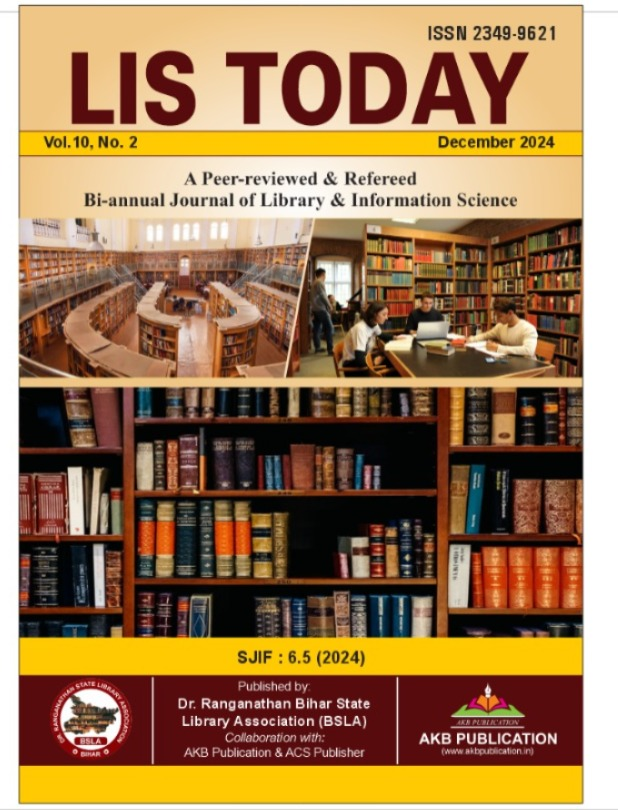MAPPING OF COLLABORATIONS AND PUBLICATIONS PATTERN OF SOCIOLOGY RESEARCH IN INDIA BETWEEN 1991 AND 2020: A SCIENTOMETRIC STUDY
Keywords:
Sociology Research, Research Evaluation, Collaborations and Publications Pattern, Sicentometrics, Bibliometrics, Indian SociologyAbstract
Recent past year, there has been renewed interest in research evaluations and it play vital role for building reputations of country, organization, institutes and also individual researcher. Several studies have documented on research evaluation using bibliometric cc indicator. In this paper, applied bibliometrics indicator for evaluate the research preference of Sociology research published in India between 1991 and 2020. We accessed Scopus database and retrieved 2410 publications. The growth of both citations and publications was not stable overtime period fluctuated. Result showed that, Indian Sociologist scholarly communion communicated in various format and preferable source of journal was “Economic and Political Weekly”. More than half of the publications communicated individually rather than collaboratively. Jawaharlal Nehru University and University of Delhi standout in top leading organization in terms of contributions. Top most frequently keyword was “India”. Indian sociologist prefers to collaborate with developing countries such as USA and UK.
References
Abramo, G., Cicero, T., & D‘Angelo, C. A. (2015). Should the research performance of scientists be distinguished by gender? Journal of Informetrics, 9(1), 25–38. https://doi.org/https://doi.org/10.1016/j.jo
i.2014.11.002
Barrot, J. S. (2017). Research impact and productivity of Southeast Asian countries in language and linguistics. Scientometrics, 110(1), 1–15. https://doi.org/10.1007/s11192-016-
2163-3
Barrot, J. S. (2023). Research on education in Southeast Asia (1996–2019): a bibliometric review. Educational Review, 75(2), 348–368. https://doi.org/10.1080/00131911.2021.1
907313
Bhui, T., & Sahu, N. B. (2018). Publications by faculty members of humanities and social science departments of IIT Kharagpur: A bibliometric study.
DESIDOC Journal of Library and Information Technology, 38(6), 403–409. https://doi.org/10.14429/djlit.38.6.13569
Brink, M. Van Den, Brouns, M., & Waslander, S. (2006). Does excellence have a gender ? A national research study on recruitment and selection procedures for professorial appointments in The Netherlands. Employee Relations, 28(6), 523–539.
https://doi.org/10.1108/01425450610704 470
Dhawan, S. M., Gupta, B. M., & Gupta, R. (2015). Social science research landscape in South Asia: A comparative assessment of research output published during 1996-2013. Library Philosophy and Practice, 2015(1).
Ebadi, A., & Schiffauerova, A. (2015). Bibliometric Analysis of the Impact of Funding on Scientific Development of Researchers. 9(5), 1435–1445.
Garfield, E. (1984). Anthropology Journals : What They Cite and What Cites Them. Current Anthropology, 25(4), 514–528.
Goel, K., & Garg, K. C. (1994). Social science research in India: A bibliometric study. Collection Management, 17(4), 95–104. https://doi.org/10.1300/J105v17n04_07
Gülgöz, S., Yedekçioglu, Ö. A., & Yurtsever, E. (2002). Turkey‘s output in social science publications: 1970-1999. Scientometrics, 55(1), 103–121. https://doi.org/10.1023/A:101605512127
4
Gupta, B. M., Dhawan, S. M., & Singh, U. (2009). Social Science Research in India, China and Brazil—A Comparative Study. DESIDOC Journal of Library & Information Technology, 29(2), 15–23. https://doi.org/10.14429/djlit.29.237
Gupta, B. M., Kumbar, B. D., & Gupta, R. (2013). Social science research in India: A Scientometric analysis of publications (2001-10). DESIDOC Journal of Library and Information Technology, 33(6), 442– 450.
https://doi.org/10.14429/djlit.33.5475
Gupta, R., Kumbar, B. D., & Tiwari, R. (2014). Ranking of Indian universities in social sciences using bibliometric indicators during 2008-12. DESIDOC Journal of Library and Information Technology, 34(3). https://doi.org/10.14429/djlit.34.7340
Kanaujia, A., Singh, P., Nandy, A., & Singh, V. K. (2022). Research contribution of major centrally funded institution systems of India. Current Science, 123(9), 1082–1088. https://doi.org/10.18520/cs/v123/i9/1082
-1088
Kaur, B., & Nagaich, S. (2019). Analysis of Social Science Research in India: A Mapping Report. SSRN Electronic Journal, October. https://doi.org/10.2139/ssrn.3397916
Khir, M., Abdullah, J., Sharunizam, S., Noor, S., & Sahid, Z. (2023). ASEAN Library and Information Science ( LIS ) research ( 2018 – 2022 ): a bibliometric analysis with strategies for enhanced global impact. In Scientometrics. Springer International Publishing. https://doi.org/10.1007/s11192-023-
04878-0
Kocyigit, B. F., & Akyol, A. (2021). Bibliometric and Altmetric Analyses of Publication Activity in the Field of Behcet‘s Disease in 2010–2019. Journal of Korean Medical Science, 36(32), 01– 10.
https://doi.org/10.3346/jkms.2021.36.e20 7
Kousha, K., & Thelwall, M. (2017). Are wikipedia citations important evidence of the impact of scholarly articles and books? Journal of the Association for Information Science and Technology, 68(3), 762–779. https://doi.org/10.1002/asi.23694
Lee, D. (2023). Bibliometric analysis of Asian ‗language and linguistics‘ research: A case of 13 countries. Humanities and Social Sciences Communications, 10(1), 1–23. https://doi.org/10.1057/s41599-
023-01840-6
Missen, M. M. S., Qureshi, S., Salamat, N., Akhtar, N., Asmat, H., Coustaty, M., & Prasath, V. B. S. (2020). Scientometric analysis of social science and science disciplines in a developing nation: a case study of Pakistan in the last decade. Scientometrics, 123(1), 113–142. https://doi.org/10.1007/s11192-020-
03379-8
Neelamma, G., & Nyamagoudar, M. R. (2017). Research Trends in Political Science Literature : A Study of Scientometric Analysis. Research Journal of Library and Information Science, 1(1), 7–14.
Norris, M., & Oppenheim, C. (2007). Comparing alternatives to the Web of Science for coverage of the social sciences‘ literature. Journal of Informetrics, 1(2), 161–169. https://doi.org/10.1016/j.joi.2006.12.001
Parabhoi, L., Verma, M. K., & Sinha, M. K. (2022). Evaluation of publications and collaboration pattern of indian social sciences research with special reference to icssr research institutes. In 2514-9342 (Ed.), 20th MANLIBNET Convention & International Conference on Libraries of the Future: Emerging Trends (pp. 573– 584). https://doi.org/9789392711060
Sangam, S. L. (2001). Collaborative Research in Psychology in India: A Scientometric Study. Proceedings of the Second Berlin Workshop on Scientometrics and Informetrics, 177–183. http://search.ebscohost.com/login.aspx?d
irect=true&db=lxh&AN=93727935&site =ehost-live&scope=site
Seaman, P., & Kaczor, S. A. (2017). 21st Century Anthropology Scholarship: A Citation Analysis. Behavioral and Social Sciences Librarian, 36(3), 122–135. https://doi.org/10.1080/01639269.2017.1
771036
Thelwall, M. (2017). Web indicators for research evaluation: A practical guide. Morgan & Claypool.
[LIS Today. Vol. 9, No. 2; Dec 2023] 10
Tripathi, M., Kumar, S., & Babbar, P. (2018). Bibliometrics of social science and humanities research in India. Current Science, 114(11), 2240–2247. https://doi.org/10.18520/cs/v114/i11/224
0-2247

